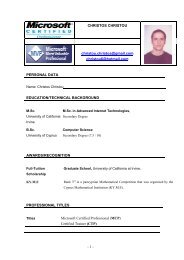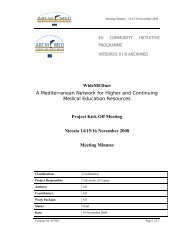Routing Protocols for Ad Hoc Mobile Wireless Networks
Routing Protocols for Ad Hoc Mobile Wireless Networks
Routing Protocols for Ad Hoc Mobile Wireless Networks
You also want an ePaper? Increase the reach of your titles
YUMPU automatically turns print PDFs into web optimized ePapers that Google loves.
<strong>Routing</strong> <strong>Protocols</strong> <strong>for</strong> <strong>Ad</strong> <strong>Hoc</strong> <strong>Mobile</strong> <strong>Wireless</strong> <strong>Networks</strong><br />
2.1 Dynamic Destination-Sequenced<br />
Distance-Vector <strong>Routing</strong> Protocol<br />
The Destination-Sequenced Distance-Vector (DSDV) <strong>Routing</strong> Algorithm [Perkins94] is based on the<br />
idea of the classical Bellman-Ford <strong>Routing</strong> Algorithm with certain improvements.<br />
Every mobile station maintains a routing table that lists all available destinations, the number of hops to<br />
reach the destination and the sequence number assigned by the destination node. The sequence number is<br />
used to distinguish stale routes from new ones and thus avoid the <strong>for</strong>mation of loops. The stations<br />
periodically transmit their routing tables to their immediate neighbors. A station also transmits its routing<br />
table if a significant change has occurred in its table from the last update sent. So, the update is both<br />
time-driven and event-driven. The routing table updates can be sent in two ways:- a "full dump" or an<br />
incremental update. A full dump sends the full routing table to the neighbors and could span many<br />
packets whereas in an incremental update only those entries from the routing table are sent that has a<br />
metric change since the last update and it must fit in a packet. If there is space in the incremental update<br />
packet then those entries may be included whose sequence number has changed. When the network is<br />
relatively stable, incremental updates are sent to avoid extra traffic and full dump are relatively<br />
infrequent. In a fast-changing network, incremental packets can grow big so full dumps will be more<br />
frequent. Each route update packet, in addition to the routing table in<strong>for</strong>mation, also contains a unique<br />
sequence number assigned by the transmitter. The route labeled with the highest (i.e. most recent)<br />
sequence number is used. If two routes have the same sequence number then the route with the best<br />
metric (i.e. shortest route) is used. Based on the past history, the stations estimate the settling time of<br />
routes. The stations delay the transmission of a routing update by settling time so as to eliminate those<br />
updates that would occur if a better route were found very soon.<br />
2.2 The <strong>Wireless</strong> <strong>Routing</strong> Protocol (WRP)<br />
The <strong>Wireless</strong> <strong>Routing</strong> Protocol (WRP) [Murthy96] is a table-based distance-vector routing protocol.<br />
Each node in the network maintains a Distance table, a <strong>Routing</strong> table, a Link-Cost table and a Message<br />
Retransmission list.<br />
The Distance table of a node x contains the distance of each destination node y via each neighbor z of x.<br />
It also contains the downstream neighbor of z through which this path is realized. The <strong>Routing</strong> table of<br />
node x contains the distance of each destination node y from node x, the predecessor and the successor of<br />
node x on this path. It also contains a tag to identify if the entry is a simple path, a loop or invalid.<br />
Storing predecessor and successor in the table is beneficial in detecting loops and avoiding<br />
counting-to-infinity problems. The Link-Cost table contains cost of link to each neighbor of the node and<br />
the number of timeouts since an error-free message was received from that neighbor. The Message<br />
Retransmission list (MRL) contains in<strong>for</strong>mation to let a node know which of its neighbor has not<br />
acknowledged its update message and to retransmit update message to that neighbor.<br />
Node exchange routing tables with their neighbors using update messages periodically as well as on link<br />
changes. The nodes present on the response list of update message (<strong>for</strong>med using MRL) are required to<br />
acknowledge the receipt of update message. If there is no change in routing table since last update, the<br />
http://www.cis.ohio-state.edu/~jain/cis788-99/adhoc_routing/index.html (3 of 20) [2/7/2000 10:38:34 AM]




